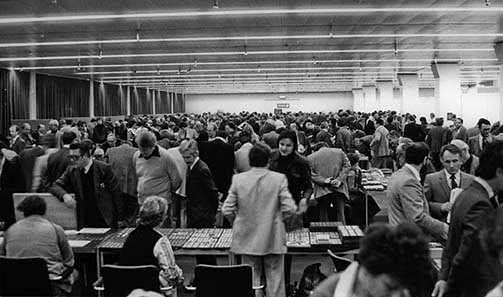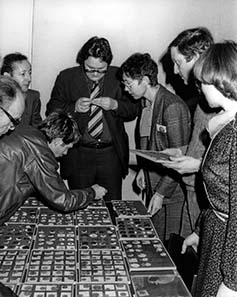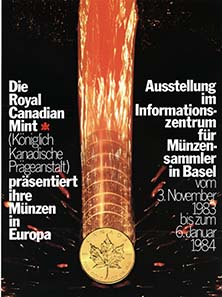January 13, 2011 – What made a little coin show in Basel / Switzerland the most known coin show all over the world? Here’s the first part of the story.
The floor during the 10th international coin show Basel in 1981.
At the Beginning, there was a Vision – and the Silver Crisis
On August 4, 1967 the U.S. Department of the Treasury took the decision to sell silver from their stocks on the free market. As the price of silver was skyrocketing, the Swiss circulation coins that contained silver were gradually replaced by new pieces of base metal. Thus, it was not really surprising that soon in every Swiss home there was a treasure box where old silver coins were hoarded.
In the course of the global silver crisis coin collecting become a widespread phenomenon – not only in Switzerland. People all over the world were investing in tangible assets in order to protect private money reserves from the risk of inflation. Precious metal coins were ideal for that purpose, being small, easy to store and extremely stable in value. The worth and diversity of classical and modern minting gradually got into the focus of public interest, with numerous new platforms and media emerging at the time.
One of the newly founded magazines was “MünzenRevue”. Behind it was Albert M. Beck. From the beginning, he had the vision of developing new forms of cooperation among numismatists, besides making a magazine. He was dreaming of a synthesis of high-quality information and the broadly conceived offer of an international coin fair that should be equally attractive for aficionados of classical and modern numismatics as well as for coins dealers, mints and minting engineers.
Silvia Hurter and Alan Walker serving clients at the table of Bank Leu.
The First International Coin Fair in Switzerland
The first International Coin Fair had a budget of only 10,000 Swiss francs – a huge sum for initiator Albert M. Beck who then was a young teacher and family father living by his wits, besides doing postgraduate studies. His commitment was to be rewarded. 87 coin dealers from all over Europe and the United States participated when the event opened in Basel for the first time. Nevertheless, hardly anybody would have expected it to become THE numismatic fair par excellence in the course of the following four decades.
The Exhibition of the Royal Canadian Mint at Schweizerische Kreditanstalt / Basel.
A Tradition is Being Established: Countries as Guest of Honor at the World Money Fair
For 30 years now the International Coin Fair, operating today under the name of World Money Fair, has invited the mint of one country as guest of honor – a wonderful tradition fathered by Albert M. Beck who started it on occasion of the 10th anniversary of Basel Coin Fair. Finland was the first guest of honor, although initially the activities were limited to an exhibition about “Bank Notes from the Union Banks of Finland” and an accompanying lecture by Dr. Hannu Paatela from Helsinki. The next to follow was the Royal Canadian Mint, the first international mint that had already drawn general attention with a sophisticated program of commemorative coins in the late 1970s. At Basel Coin Fair, the guests from Canada finally achieved the media response they had long been hoping to get in Europe. As a lot of others wanted to secure that success for themselves, a long line of guests of honor was to follow.
Patrice Cahart, then president of the Monnaie de Paris shows a commemorative coin on the occasion of the Olympic Games in Albertville 1992.
Worldwide Media Attention
Close cooperation with the specialized press and the interested public has always been a matter of fact for Beck. As editor of “MünzenRevue” magazine he knows about the needs of journalists, always providing them with informative press material and organizing press conferences with select speakers. His greatest achievement, however, was the founding of the Media Forum, still regarded as the most important media event in the world of numismatics. ?Again, an anniversary was the motivation for introducing this new event format, although in terms of technology it was rather limited at first – 20 years after the “invention” of the Basel Coin Fair. At that time, many of the participating mint directors used to hold up cardboard disks when presenting their coin programs for the coming year. This has profoundly changed since then, but the original concept of the event is still convincing. Today, up to twenty international mints showcase their current coin programs, while a lot of specialized journalists and interested collectors use this unique information event to talk with the “makers” directly.
Modern and Classical Numismatics, United at the World Money Fair
Besides pieces of modern coinage, classical numismatics has always been part and parcel of the World Money Fair and its Basel predecessors, not only on the tables of coin dealers. Besides academically oriented numismatic societies and institutions, important auction houses have ever since participated in the fair. During the Switzerland years, it was mainly the Swiss Bank Cooperation (today UBS) that conducted auctions, while today the German auction house Fritz Rudolf Künker is a guarantor of extraordinary auction events. Connoisseurs will find numismatic rarities from times long past, lately including a vast choice of Russian coins. Located where eastern and western Europe meet, Berlin has developed to become a great marketplace where top prices at auctions are consistently being achieved.
by courtesy of the World Money Fair
If you want to read the second part of the story, click here.








